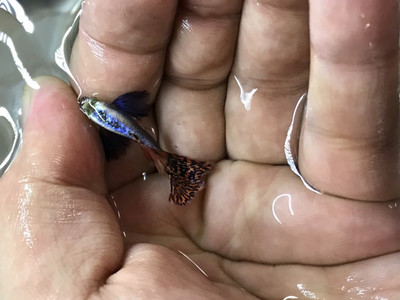Dumbo Guppy
Posted by Max Gandara on on 2nd Jan 2024
The Dumbo Guppy, scientifically known as Poecilia reticulata, is a
captivating variant of the common guppy. Its unique feature is the
enlarged pectoral fins resembling Dumbo elephant ears, making it a
popular choice among aquarium enthusiasts. Guppies, in general, belong
to the Poeciliidae family with a genome characteristic of livebearers,
and their evolution line involves adaptations to various freshwater
habitats, originating in South America.
Summary of Aquatic Life:
Dumbo Guppies are known for their vibrant colors, live-bearing nature,
and distinctively large pectoral fins. Males showcase elaborate
courtship displays, and females give birth to live fry. They prefer
well-planted aquariums with a mix of floating and submerged vegetation.
These small and peaceful fish thrive in community setups, appreciating a
varied diet of high-quality flakes, pellets, and occasional live or
frozen foods.
Creating a Happy and Healthy Environment:
1. Tank Size: Provide a tank of at least 10 gallons for a small group of guppies.
2. Water Parameters: Maintain a temperature range of 75-82°F (24-28°C) and slightly alkaline water (pH 7.0-7.5).
3. Filtration: Use efficient filtration to keep the water clean and well-oxygenated.
4. Substrate and Decor: Use fine-gravel substrate with live or artificial plants for hiding spots.
5. Feeding: Offer a varied diet including flakes, pellets, and occasional live or frozen foods.
Compatible Aquatic Life:
Fish:
1. Platy (Xiphophorus maculatus): Similar size and peaceful temperament for a harmonious tank.
2. Endler's Livebearer (Poecilia wingei): Small livebearers, compatible with guppies in a community setup.
3. Neon Tetra (Paracheirodon innesi): Peaceful schooling fish adding color to the aquarium.
4. Honey Gourami (Trichogaster chuna): Small, peaceful labyrinth fish that coexist well.
5. Corydoras Catfish (Corydoras spp.): Bottom-dwelling companions for a balanced ecosystem.
Crustaceans:
1. Red Cherry Shrimp (Neocaridina davidi): Colorful and non-aggressive tankmates.
2. Amano Shrimp (Caridina multidentata): Efficient algae cleaners compatible with guppies.
3. Ghost Shrimp (Palaemonetes spp.): Inexpensive and harmless tank cleaners.
4. Bamboo Shrimp (Atyopsis moluccensis): Filter-feeding shrimp suitable for larger setups.
5. Vampire Shrimp (Atya gabonensis): Peaceful filter-feeding shrimp.
Plants:
1. Java Fern (Microsorum pteropus): Hardy, low-maintenance plant for a natural aesthetic.
2. Amazon Sword (Echinodorus amazonicus): Tall background plant providing cover.
3. Water Wisteria (Hygrophila difformis): Fast-growing plant for water quality and aesthetics.
4. Duckweed (Lemna minor): Floating cover for a more secure environment.
5. Cryptocoryne (Cryptocoryne spp.): Rooted plants adding to the overall habitat.
Bugs:
1. Daphnia: Nutrient-rich live food for guppies.
2. Mosquito Larvae: Natural and occasional live food.
3. Fruit Flies: Small, flying insects for variety in the diet.
4. Bloodworms: High-protein live or frozen food.
5. Brine Shrimp: Excellent for conditioning and variety in diet.
Amphibians:
1. Dwarf African Clawed Frog (Hymenochirus spp.): Peaceful aquatic frogs.
2. African Dwarf Frog (Hymenochirus curtipes): Small, aquatic frogs compatible with guppies.
3. Fire-Bellied Newt (Cynops spp.): Semi-aquatic newts suitable for a shared habitat.
4. Oriental Fire-Bellied Toad (Bombina orientalis): Colorful toads for a unique aquatic setup.
5. Mudskipper: Brackish water amphibian, providing a dynamic ecosystem.
These considerations contribute to a diverse and balanced aquatic
community, ensuring the well-being of Dumbo Guppies and their tankmates.

